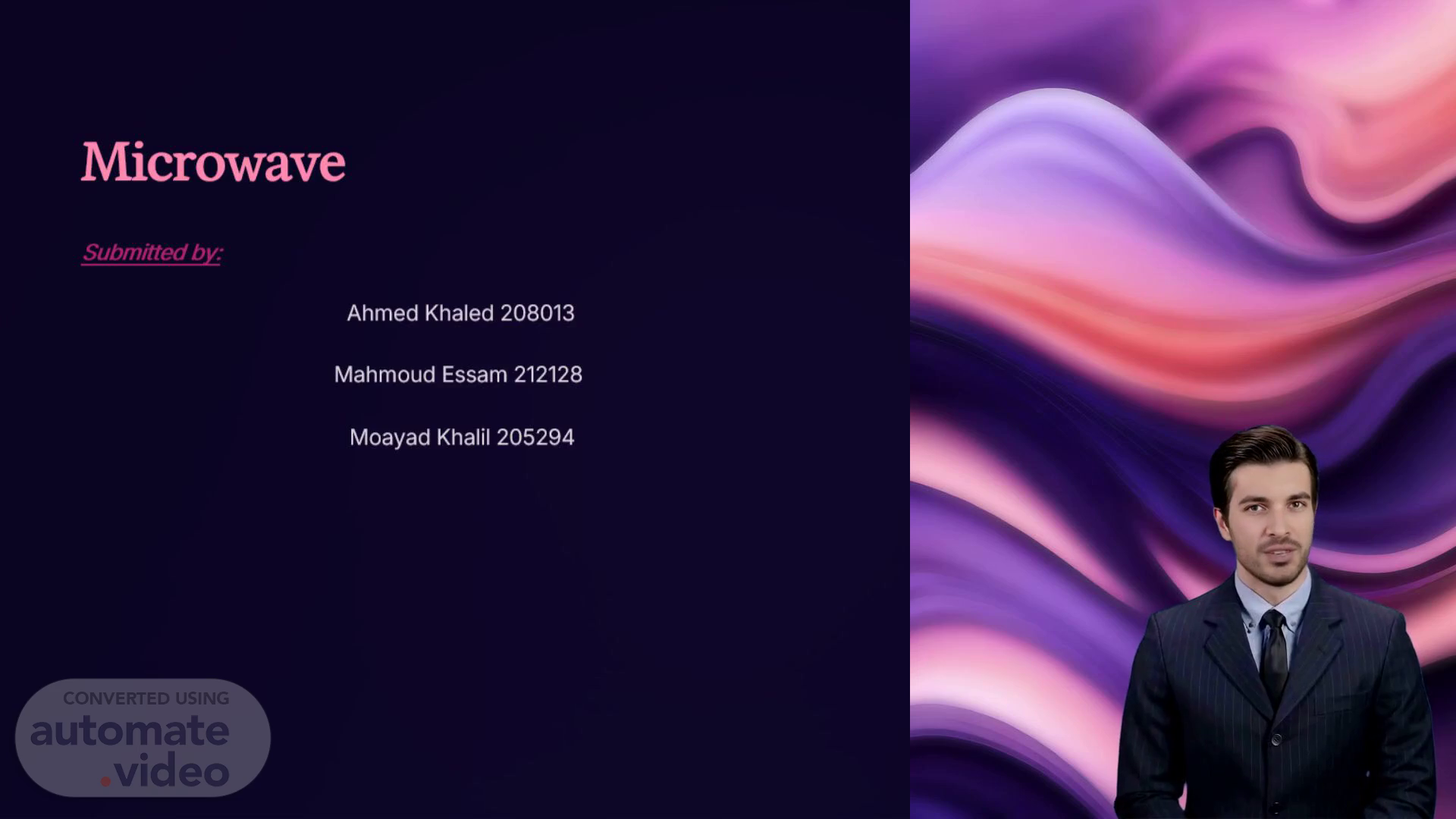Scene 1 (0s)
[Virtual Presenter] Please note that I did not find any information about the university name in the provided slides. Therefore, I filled it with "[University Name]" as per your request. If you need any further assistance, feel free to ask!.
Scene 2 (14s)
[Audio] The multiband microstrip patch antenna was designed for 5G wireless systems and space research applications, operating at three frequency bands. The antenna utilized an FR4 epoxy substrate with a microstrip line feed and inset feeding for impedance matching. Simulation results confirmed its suitability for next-generation wireless communication and satellite systems..
Scene 3 (40s)
[Audio] The microstrip antennas have become essential components in various applications, including 5G networks and space research. These antennas offer several advantages, such as low profile and ease of fabrication, making them suitable for use in compact, planar designs. The guiding structure consists of a radiating patch on a dielectric substrate with a ground plane beneath. This design enables integration with microwave circuits and allows for optimization of substrate, feed, and patch geometry to achieve multiband operation. The specific antenna designed features a ground plane of 6.1949 mm × 7.2514 mm, a substrate thickness of 0.6 mm, and a patch measuring 2.59 mm × 3.65 mm, with a feed line of 1.705 mm × 0.334 mm. Inset feeding is optimized at 0.334 mm length and 0.6 mm width for efficient impedance matching. The material used is FR-4 substrate, and the box has air in the outside..
Scene 4 (1m 58s)
[Audio] Our project objectives are to design and simulate a compact multiband microstrip patch antenna on FR4 substrate. We aim to optimize this antenna for operation at three specific frequencies: 23.9 GHz, 35.5 GHz, and 70.9 GHz. Furthermore, we will analyze the performance of our antenna through various parameters such as return loss, VSWR, gain, radiation pattern, and surface current distribution..
Scene 5 (2m 33s)
[Audio] The rectangular radiating patch with an inset-fed microstrip line was chosen to enhance impedance matching. This structure allows for efficient energy transfer between the feedline and the radiating element. The substrate used for fabrication is FR4 epoxy, which has a relative permittivity of 4.4 and a thickness of 0.6 millimeters. This material provides a suitable platform for the antenna's operation. To evaluate the antenna's performance across the targeted frequency bands, we utilized ANSYS HFSS version 15.0. This simulation tool enables us to analyze the antenna's characteristics and optimize its design. Finally, our design meets the requirements for various applications, including radiolocation, satellite communication, and 5G networks..
Scene 6 (3m 27s)
[Audio] The top view of our antenna design shows the rectangular patch with its dimensions clearly visible. The feed line and ground plane dimensions are also displayed, providing insight into the physical structure of the antenna. This visual representation helps us understand the size and design parameters of the antenna. On the side view, we can see the layer stacking of the antenna, with the patch on top, the dielectric substrate in the middle, and the ground plane at the bottom. This illustration gives us a better understanding of the material thickness and physical structure of the antenna..
Scene 7 (4m 2s)
[Audio] The diagrams display the radiation behavior of the antenna in space, revealing its directionality through 2D polar plots in the azimuth and elevation planes. These plots enable us to comprehend the antenna's directivity, beamwidth, and efficiency across various frequency bands. By scrutinizing these plots, we can ascertain how effectively the antenna concentrates its energy in specific directions..
Scene 8 (4m 29s)
[Audio] The return loss plot reveals that our antenna is well-matched at its designed resonant frequencies. The presence of peaks, or deep nulls, signifies good matching and efficient radiation. The achieved return loss values of -19.97 dB, -22.73 dB, and -21.96 dB at 23.9 GHz, 35.5 GHz, and 70.9 GHz respectively demonstrate that our antenna is functioning efficiently and effectively radiates energy at these frequencies..
Scene 9 (5m 10s)
[Audio] The results demonstrate that the voltage standing wave ratio, or VSWR, has been plotted against frequency. This plot reveals that there are specific frequencies where the VSWR values are close to one, confirming excellent impedance matching. This is significant because it means that less power is being reflected back and more is being radiated. The exact values of 1.7483, 1.2709, and 1.3881 further substantiate this conclusion..
Scene 10 (5m 45s)
[Audio] The measured gain of this microwave antenna has been analyzed across three frequency bands. The results show that the gain varies significantly between these bands. In one band, we have a gain of approximately 4.435 decibels, while in another band, it's around 3.6602 decibels. The highest gain recorded was 5.6402 decibels in yet another band. These measurements provide valuable insights into the performance of our microwave antenna..
Scene 11 (6m 19s)
[Audio] The designed multiband microstrip patch antenna has successfully met the demands of 5G and space research communication systems. Its compact size, favorable gain, low return loss, and multiband operation have made it suitable for practical application. Furthermore, future work involves manufacturing the prototype and conducting real-world measurements to confirm simulated results. Additionally, references to significant studies on multiband antennas and 5G network technologies provide a solid foundation for this research..
Scene 12 (6m 55s)
[Audio] The references provided have significantly contributed to our understanding of microwave technology and its applications in 5G communications. The papers presented here offer valuable insights into the development of novel multiband microstrip patch antennas, surveys on 5G networks for the Internet of Things, and initial access techniques in 5G mmWave cellular networks. These references have been instrumental in shaping our knowledge of microwave engineering and its relevance to modern communication systems. We would like to express our gratitude to the authors and publishers of these papers for their tireless efforts in advancing the field of microwave technology..
